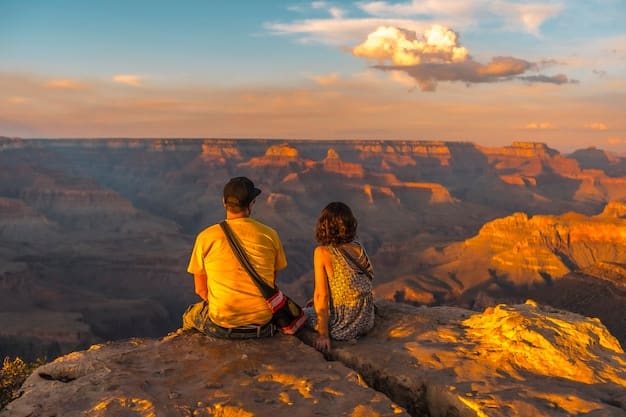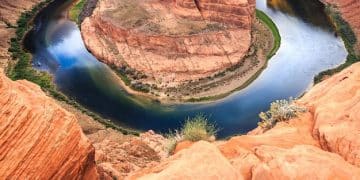Maximize Your 2025 US National Park Pass: Top Tips & Hidden Gems

Maximize Your 2025 US National Park Pass: Insider Tips and Hidden Gems is your comprehensive guide to unlocking the full potential of your pass. Discover how to plan smarter, explore hidden gems, and make unforgettable memories while saving money and experiencing the best of America’s national parks.
Embarking on a journey through America’s national parks is an unforgettable experience, and the US National Park Pass is your key to unlocking these natural treasures. This guide, How to Maximize Your 2025 US National Park Pass: Insider Tips and Hidden Gems, will provide you with everything you need to plan your adventures, discover hidden gems, and make the most of your pass.
Understanding Your 2025 National Park Pass
The America the Beautiful Pass, more commonly known as the National Park Pass, grants you access to over 2,000 federal recreation sites. Understanding what it covers and its limitations is crucial to maximizing its value.
What the Pass Covers
The pass covers entrance fees at national parks and national wildlife refuges, as well as standard amenity fees at national forests and grasslands. It admits the pass holder and any accompanying passengers in a single, private, non-commercial vehicle, or the pass holder and up to three additional adults at sites where per-person fees are charged.
Limitations of the Pass
While the pass covers entrance and amenity fees, it does not cover expanded amenity fees such as camping, reservations, tours, or special permits. It’s essential to check the specific park’s website or contact them directly to understand what is covered and what isn’t.
- Check the park’s website for fee details.
- Understand the difference between entrance and amenity fees.
- Be aware of any reservation requirements.
By understanding the coverage and limitations, you can effectively plan your park visits and avoid unexpected costs.
Planning Your Park Adventures
Strategic planning is key to maximizing the value of your National Park Pass. Consider visiting multiple parks, exploring during off-peak seasons, and utilizing online resources to map out your route.
Visiting Multiple Parks
The more parks you visit, the more you save. Plan a road trip that includes several national parks along a particular route. This allows you to experience a variety of landscapes and activities while making the most of your pass. For example, a trip through Utah could include Zion, Bryce Canyon, and Arches National Parks.
Exploring During Off-Peak Seasons
Visiting parks during the shoulder seasons, such as spring or fall, can provide a more peaceful experience and often lower accommodation costs. Parks are less crowded, and the weather is often pleasant. For example, visit Acadia National Park in Maine during the fall for stunning foliage and fewer crowds.
- Research the best times to visit each park.
- Consider weather conditions and seasonal activities.
- Book accommodations and tours in advance, especially during peak season.
Careful planning allows you to optimize your visits, save money, and avoid crowds, enhancing your overall experience.

Discovering Hidden Gems and Lesser-Known Parks
While iconic parks like Yellowstone and Yosemite are must-sees, the National Park System also includes many smaller, lesser-known gems that offer unique experiences and fewer crowds.
Congaree National Park, South Carolina
Home to some of the tallest trees in the eastern United States, Congaree National Park offers unique hiking and paddling experiences. Explore the boardwalk trails through the old-growth forest or take a guided canoe tour down the Congaree River.
Great Basin National Park, Nevada
This park boasts diverse landscapes, from the towering Wheeler Peak to the mysterious Lehman Caves. Hike to the summit of Wheeler Peak or explore the underground wonders of the caves. The park also offers excellent stargazing opportunities due to its remote location and minimal light pollution.
- Research lesser-known parks in your area.
- Look for unique activities and ranger-led programs.
- Enjoy the solitude and beauty of less-crowded destinations.
Exploring these hidden gems can provide a more intimate and rewarding experience, away from the hustle and bustle of the more popular parks.
Maximizing Value with Additional Perks
Beyond entrance fees, the National Park Pass can unlock additional perks and discounts. Take advantage of these opportunities to save money and enhance your park experience.
Discounts on Camping Fees
Some parks offer discounts on camping fees for pass holders. Check the specific park’s website or contact the park directly to inquire about camping discounts. These discounts can significantly reduce the cost of overnight stays within the parks.
Educational Programs and Guided Tours
Many parks offer free educational programs and ranger-led tours. These programs provide valuable insights into the park’s history, geology, and wildlife. Check the park’s schedule for available programs and tours to enrich your visit.

- Inquire about camping discounts at the park’s visitor center.
- Check the park’s website for a schedule of educational programs.
- Engage with park rangers to learn more about the park’s unique features.
Taking advantage of these additional perks can significantly enhance your visit and provide a deeper appreciation for the natural and cultural resources of the parks.
Understanding the Fine Print: Rules and Regulations
To ensure a smooth and enjoyable experience, it’s essential to understand the rules and regulations associated with the National Park Pass. These guidelines help protect the parks and ensure the safety of all visitors.
Transferability and Identification
The National Park Pass is non-transferable and must be signed by the pass holder. When entering a park, be prepared to show a valid photo identification matching the name on the pass. This helps prevent unauthorized use of the pass.
Vehicle Restrictions
The pass covers entrance fees for a single, private, non-commercial vehicle. If you are traveling in a large group or commercial vehicle, you may need to pay additional fees. Check the park’s website or contact them directly for specific vehicle restrictions.
- Sign your pass immediately upon receiving it.
- Carry a valid photo identification with you at all times.
- Be aware of vehicle restrictions and additional fees.
Understanding these rules and regulations ensures that you can enjoy the parks responsibly and without any unexpected issues.
Tips for a Sustainable Park Visit
Protecting the environment and preserving the natural beauty of the national parks is crucial for future generations. Here are some tips for a responsible and sustainable park visit.
Leave No Trace
Practice the principles of Leave No Trace by packing out all trash, staying on designated trails, and minimizing your impact on the environment. This helps preserve the natural beauty of the parks and ensures that others can enjoy them as well.
Respect Wildlife
Observe wildlife from a safe distance and never feed or approach animals. Feeding wildlife can disrupt their natural behaviors and make them dependent on humans. Respect their space and observe them from a distance using binoculars or a camera.
- Pack out all trash and dispose of it properly.
- Stay on designated trails to avoid damaging vegetation.
- Observe wildlife from a safe distance and never feed them.
By following these tips, you can help protect the environment and ensure that the national parks remain pristine for future generations.
| Key Point | Brief Description |
|---|---|
| 💰 Maximize Value | Visit multiple parks; use off-peak seasons. |
| 🏞️ Hidden Gems | Explore lesser-known parks like Congaree & Great Basin. |
| 🌲 Sustainability | Practice Leave No Trace; respect wildlife. |
| ✅ Pass Coverage | Covers entrance fees, not camping or tours. |
FAQ Section
The pass covers entrance fees at National Parks and National Wildlife Refuges. It also covers standard amenity fees at National Forests and National Grasslands. However, it does not cover camping or tour fees.
No, the National Park Pass is non-transferable. It can only be used by the person who signed the pass. When using the pass, you may be asked to show a photo ID.
Yes, the pass admits the pass holder and any accompanying passengers in a single, private, non-commercial vehicle. For per-person fee sites, the pass admits the pass holder and up to three additional adults.
Yes, seniors (62+) can purchase a Senior Pass, which offers lifetime or annual access. Active military members and veterans may be eligible for a free Military Pass. Check the National Park Service website for details.
Lost or stolen passes are not replaceable. You will need to purchase a new pass if your original one is lost or stolen. Be sure to keep your pass in a safe and secure location.
Conclusion
Maximizing your 2025 US National Park Pass involves careful planning, exploration of lesser-known parks, and a commitment to sustainable travel. With these insider tips, you’re well-equipped to embark on unforgettable adventures while making the most of your pass and contributing to the preservation of America’s natural treasures.





